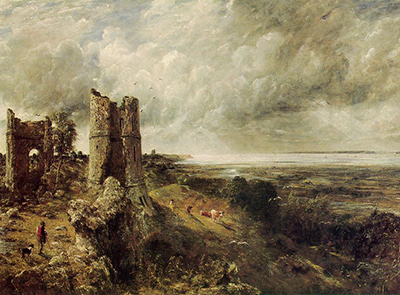When celebrated English artist, John Constable visited Hadleigh Castle, no one knew the result would be one of the most revered pieces of art.
It all started with a small drawing on the site back in 1814. Then came a full-size sketch that paved the way for a finished oil painting completed in 1829 to be exhibited the same year at the Royal Academy.
Success for John Constable was long in coming. His work was first criticised even by the Royal Academy as unsophisticated. However, his revolutionary spirit together with an unexceptional gift in creation of landscapes saw him to the top. Today, he is celebrated as one of the most influential Romantic artists in England.
His Romanticism is evident in the Hadleigh Castle in which he makes an inseparable marriage between nature and emotion. He uses intense colour and the effects of nature to bring out life and emotional appeal characteristic in most of his other paintings including The White Horse, Stratford Mill and The Hay Wain. He believed that nature is temporary and sentimental and made great efforts in expressing his views through his work.
The painting is a vivid depiction of what is left after nature takes its toll on the Hadleigh Castle. Two surviving towers in decrepit condition stand forlornly at the left of the plane. The ruins are overgrowing with foliage and underbrush.
In the lower corner on the left, a shepherd is faithfully followed by his dog. Another figure lies near one of the towers to the right. He is a herder who is in charge of the three cows grazing on the rugged hillside. On the right too is an estuary which finally takes the eastern path.
There are several seagulls whose direction of flight is towards the horizon. Characteristic of most other of Constable’s paintings, the clouds hang in the sky in all their expressive power. Breaking through them and illuminating the horizon are the symbolic rays of sunlight.
Much of Constable’s influence in creation of Hadleigh Castle came from his personal emotions. The painting was completed at a time of devastation and despair for the artist. He had just lost his wife, Maria, to tuberculosis and there is no clearer way to peer into his heart and understand his emotional pain than studying the painting.
Perhaps there is a brighter side to Constable’s expression of his feelings through the Hadleigh Castle. In 1829, he was finally allowed full membership to the Royal Academy. The President of the Academy, Sir Thomas Lawrence, said that the artist was lucky to clinch the membership because he had competed with some of the best painters and the painting may have been an expression of the burden of having to fulfill the high expectations coming with the election while still trying to come to terms with loss of his wife.
Constable’s ability to depict rural life in all vividness is in the least, legendary. He effortlessly evokes emotions and brings nature to life in all its raw form on canvas. While every one of his paints possesses the power to draw the attention of both the body and the soul, Hadleigh Castle is in a class of its own.




